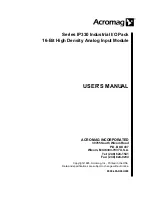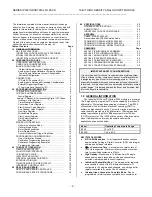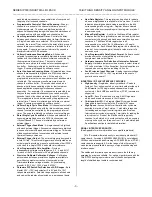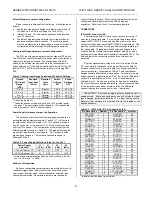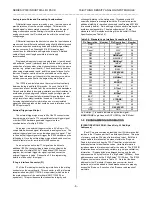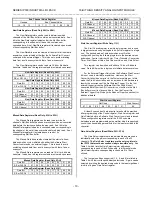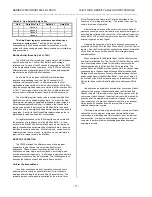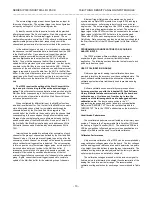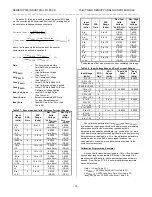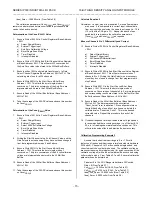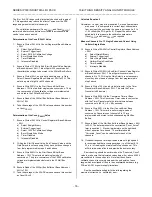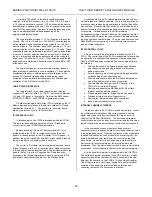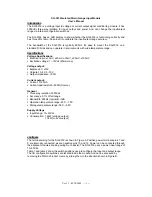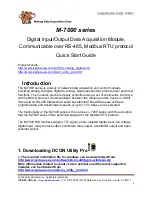
SERIES IP330 INDUSTRIAL I/O PACK 16-BIT HIGH DENSITY ANALOG INPUT MODULE
___________________________________________________________________________________________
- 3 -
each individual channel or upon completion of conversion of
the group of all scanned channels.
•
Programmable Control of Channel Scanning
- Scan all
channels or a subset of the channels to allow an overall
higher sample rate. The channels digitized include all
sequential channels beginning with a specified start-channel
value and ending with a specified end-channel value.
•
User Programmable Interval Timer
- Controls the delay
between each channel converted when Uniform-Continuous
or Single Scan modes are selected. If Burst-Continuous is
selected, the Interval Timer controls the delay after a group of
channels are converted before conversion is initiated on the
group again. Supports a minimum interval of 8
µ
sec and a
maximum interval of 2.09 seconds.
•
Uniform Continuous Scanning Mode
- All channels
selected for scanning are continually digitized in a round robin
fashion with the interval between conversions controlled by
the programmed interval timer. The results of each
conversion are stored in the channel’s corresponding mail
box buffer. Scanning is initiated by a software or external
trigger. Scanning is stopped by software control.
•
Burst Continuous Scanning Mode
- All selected input scan
channels are sequentially digitized at a 67KHz conversion
rate (15
µ
second conversion time). At the end of a
programmed interval time a new conversion of all channels is
re-initiated. The conversion results are stored in each
channel’s mail box buffer. This mode can be used as a
pseudo-simultaneous sampling mode for low to medium
speed applications requiring simultaneous channel
acquisition. For example, if four channels are selected then
they could be pseudo-simultaneously converted every 60
µ
seconds (each of the channels actually takes 15
µ
seconds).
This is repeated in bursts determined by the programmed
interval time. The scan is initiated by a software or external
trigger. Scanning is stopped by software control.
•
Uniform Single Cycle Scan Mode
- All channels selected for
scanning are digitized once with the idle time between each
channel conversion controlled by the programmed interval
timer. The scan is initiated by a software or external trigger.
•
Burst Single Cycle Scan Mode
- All channels selected for
scanning are digitized once at a 66.7KHz conversion rate
(15
µ
sec/Channel). The scan is initiated by a software or
external trigger.
•
External Trigger Scan Mode
- A single channel is digitized
with each external trigger. Successive channels are digitized
in sequential order with each new external trigger. This mode
allows synchronization of conversions with external events
that are often asynchronous.
•
External Trigger Output
- The external trigger is assigned to
a field I/O line. This external trigger may be configured as an
output signal to provide a means to synchronize other IP330’s
or devices to a single IP330’s on board timer reference.
•
User Programmable Gain Amplifier
- Provides
independently software controlled gains (1, 2, 4, and 8V/V)
for each of the 16 differential or 32 single-ended channels.
•
Precision On Board Calibration Voltages
- Calibration
autozero and autospan precision voltages are available to
permit host computer correction of conversion errors.
Trimmed calibration voltages include: 0V (local analog
ground), 4.9V, 2.45V, 1.225V, and 0.6125V.
•
Hardware DIP Switch For Selection of A/D Ranges
- Both
bipolar (
±
5V,
±
10V) and unipolar (0 to 5V and 0 to 10V)
ranges are available. Selected range applies to all channels
and can-not be individually selected on a per channel basis.
•
New Data Register
- This register can be polled, to indicate
when new digitized data is available in the mail box. A set bit
indicates a new digitized data value is available in the bit’s
corresponding mail box register. Register bits are cleared
upon read of their corresponding mail box register or start of
a new scan cycle.
•
Missed Data Register
- A set bit in the Missed Data register
indicates that the last digitized value was not read by the host
computer quickly enough and has been overwritten by a new
conversion. The Missed Data register has a bit
corresponding to each of the 16 differential or 32 single-
ended channels. Each Missed Data register bit is cleared by
a read of its corresponding mail box data value or start of a
new scan cycle.
•
User Programmable Data Output Format
- Software control
provides selection of straight binary or binary two’s
complement data output format.
•
Hardware Jumpers For Selection of Internal or External
Supply
- Hardware jumper provide a means to select internal
±
12 volts or external
±
15 volt supplies. External supplies are
required when using inputs exceeding
±
8.5 volts.
•
Fault Protected Input Channels
- Analog input overvoltage
protection from -35 V to +55 V is provided in the event of
power loss or power off.
INDUSTRIAL I/O PACK INTERFACE FEATURES
•
High density -
Single-size, industry standard, IP module
footprint. Four units mounted on a carrier board provide up to
64 differential or 128 single-ended channels in a single
system slot. Both VMEbus and ISA bus (PC/AT) carriers are
supported.
•
Local ID
- Each IP module has its own 8-bit ID signature
which can be read via access to the ID space.
•
16-bit and 8-bit I/O
- Port register Read/Write is performed
through data transfer cycles in the IP module I/O space.
•
High Speed
- Access times for all data transfer cycles are
described in terms of "wait" states - 1 wait state is required
for reading and writing all control registers and ID values.
Interrupt select cycles also require 1 wait state for reading the
interrupt vector. Read of the Mail Box buffers typically
requires 1 wait state but, to avoid contention with an ongoing
memory write cycle, could require from 1 to 6 wait states (see
Specifications section for detailed information).
SIGNAL INTERFACE PRODUCTS
(See Appendix for more information on compatible products)
This IP module will mate directly to any industry standard IP
carrier board. Acromag’s AVME9630/9660 3U/6U non-intelligent
VMEbus carrier boards and Acromag’s APC8600 ISA bus (PC/AT)
carrier board are supported. A wide range of other Acromag IP
modules are also available to serve your signal conditioning and
interface needs.
The cables and termination panels, described in the following
paragraphs, are also available. For optimum performance with the
16-bit IP330 analog input module, use of the shortest possible
length of shielded input cable is recommended.

